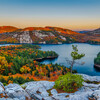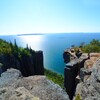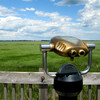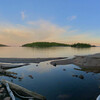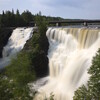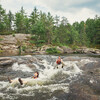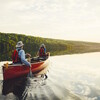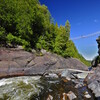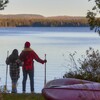
16 of the Coolest Animals You Can See in Ontario
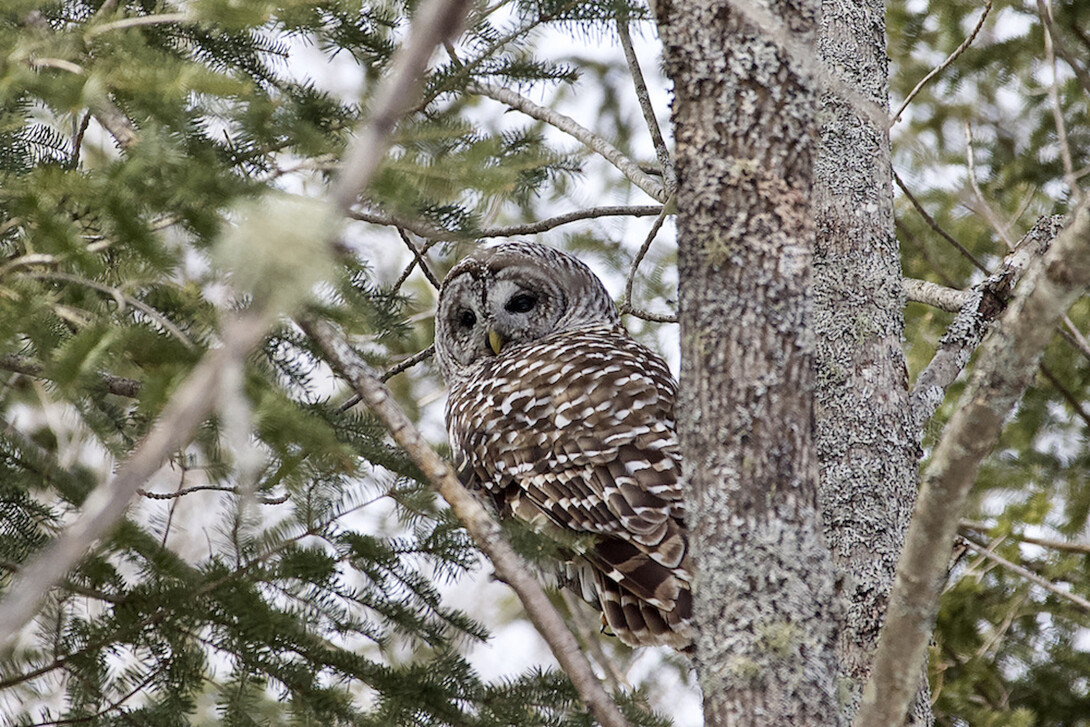
One of the greatest things about calling Northern Ontario home is the massive amount of wild space we share with so many animal species. We’re spoiled here, and taking this biodiversity for granted is easy. Watching wildlife is a terrific way to pass the time and better appreciate all the other fascinating lifeforms that share our planet.
All seasons are good for seeing different types of Ontario wildlife. Mammals tend to stand out much more in the winter, contrasting against the white snow. Birds are more abundant in spring and summer, along with black bears and beavers and other species that migrate or take a break in the winter.
From large, charismatic moose grazing in wetlands to tiny lizards under rocks, our province is full of wildlife—if you know where to look. This article provides an introduction to a few of our four-legged and feather-covered neighbours, some of which you may see on your next Ontario trip.
Before we jump in, we do want to note the importance of respecting the wildlife that calls our outdoor spaces home. Make sure to keep your distance and never feed or interact with the wildlife you see, no matter how big or small the animal might be. It's worth bringing along binoculars so you can get a better look without getting too close!
Owls
Owls hold a fixation over nature lovers. They are all around us but seldom seen. Most owls hunt at night and stay motionless during the day, nestled deep in the branches of trees. Consider yourself lucky if you’ve ever got a good look at an owl in the wild: it’s a rare opportunity.
Owls are raptors, the same family as hawks. They use their sharp talons and razor-sharp eyesight for hunting other animals. Most species are active at night, counterparts to hawks or harriers we may see during the day. The 11 different types of owls in Ontario vary in appearance, habitats and characteristics. To see all species (even in a lifetime) would be any birder’s dream; but here are some tips for catching a glimpse of some of them.
Barred owls (Strix varia) and great horned owls (Bubo virginianus) are two of the most common owls. Barred owls have a deep song that sounds like “who cooks for you.” Meanwhile, great horned owls give a classic “hoo-hoo-hoo” sound that you would expect of an owl. Snowy owls (Bubo scandiacus) are instantly recognizable. They are also one of the few owls that are active during the day. “Snowies” breed on the high tundra and move south during the coldest parts of winter. Depending on prey availability, they can move throughout Ontario, right to the U.S. border. They spend their summers north of the Arctic Circle; when they venture south, you can find them hanging in flat areas like open fields or shorelines and other places resembling the tundra. Watch for their intense yellow eyes.
Generally, owls hunt in areas with enough open space to swoop down and take prey. You’re more likely to hear one than to see it, so keep your ears peeled in more open spaces where sounds travel farther. Listen for owls an hour before or after daylight, when the birds are most vocal. Owls breed slightly earlier than songbirds’ spring season, so the best time to hear them is in the late winter. Take a ski or snowshoe down a quiet trail, and pause frequently to listen. If you’re fortunate, you’ll spot the owl beginning its nightly hunt. Staying at one of Ontario Parks’ winter accommodations like a Quetico Cabin is a great way to hear owls.
If you find an owl roosting in the daytime, congratulations! They are notoriously challenging to find even for seasoned naturalists. As nocturnal animals, the day is their resting time. It’s good practice to keep a fair distance from roosting owls so as not to disturb or draw attention to them. Crows, ravens and blue jays will “mob” the owl if they find it, harassing it and causing the animal to burn precious energy escaping.
There is some heated controversy over viewing owls as they are very sought after by wildlife photographers. Like crows, ravens and jays, humans can mob known roosts of owls in hopes of getting the perfect shot of them. Some photographers offer tips on how to attract owls, primarily through baiting. This is unethical and can endanger the owl. Read Birds Canada’s guidelines for owl observation here.
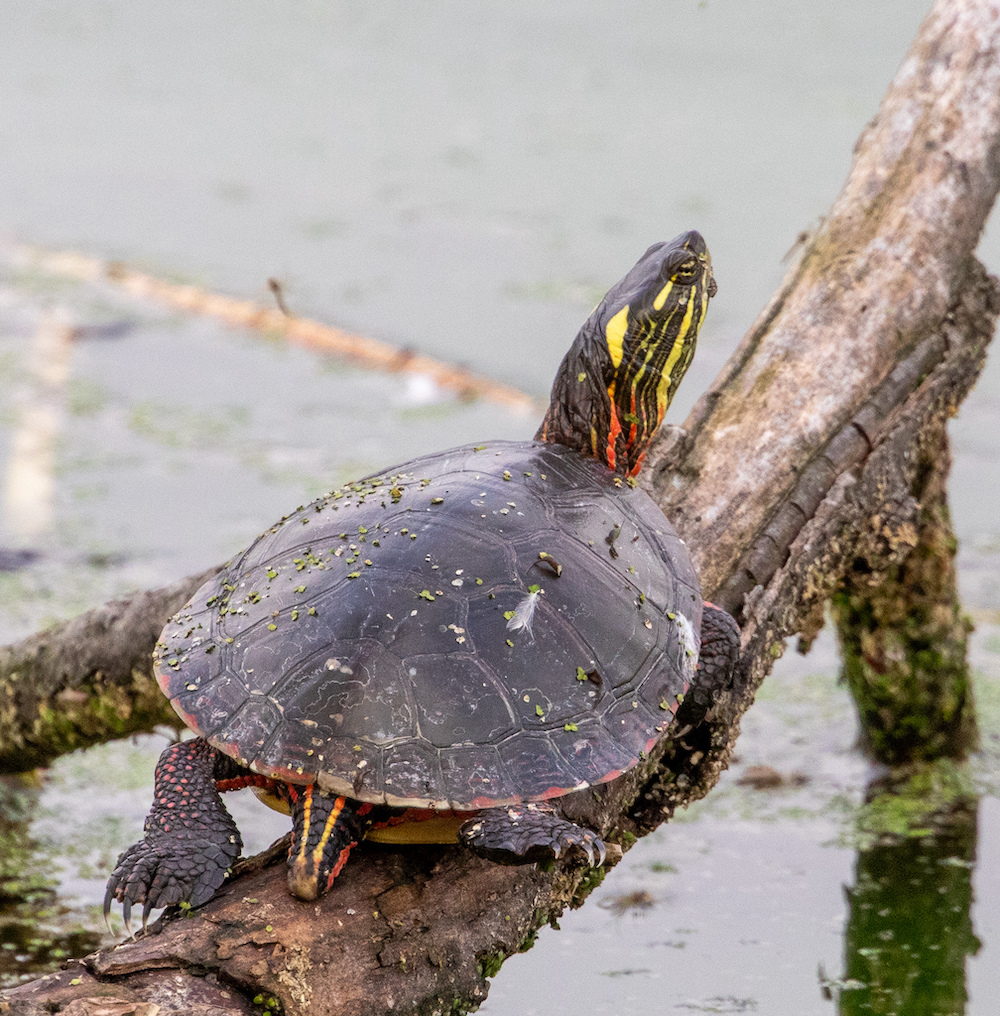
Turtles
There are eight native species of turtles in Ontario, including the common snapping turtle, spotted turtle, common musk turtle, painted turtle, wood turtle, spiny softshell turtle, Blanding’s turtle, and the northern map turtle. Sadly, all eight turtles are now at risk of disappearing from Ontario’s landscape—primarily due to human activities.
Turtles are a keystone species vital in keeping wetlands and shorelands clean. A large portion of a turtles' diet consists of dead animal and plant matter. Around 70 percent of Ontario’s wildlife depends on wetlands and shorelands, and unfortunately, 70 to 90 percent of Ontario’s wetlands have disappeared due to development.
The eight Ontario turtles range mostly in Southern Ontario due to warmer climates. In Northern Ontario, you may encounter the hardy snapping turtle (Chelydra serpentina) or a painted turtle (Chrysemys picta) on a warm summer day.
Turtles are semiaquatic and can be found in a variety of wet habitats depending on the species you are looking for. These habitats include lakes, rivers, marshes, fens, swamps and bogs. Some turtles like to stay closer to water, while others like to venture farther away on land at certain times of the year.
Snapping turtles are the largest freshwater turtle and can be found in slow-moving water with soft mud or sandy bottoms. They have dark shells, long tails and can grow to a length of up to 36 cm and weigh as much as 26 kg. Snapping turtles can live for over 100 years!
During the winter, they hibernate in the mud or silt at the bottom of lakes and rivers. Snapping turtles can’t retract themselves into their shells like some other turtle species, so they need other mechanisms for defending themselves. They’re a highly combative species that can snap their powerful jaws to defend themselves or swing their stegosaurus-like tail, but only on land. Rarely will they snap at people or pose threats in the water.
Painted turtles have the broadest range of freshwater turtles in Canada. In Northern Ontario, you’ll come across two subspecies: the midland painted turtle and western painted turtle. These two get confused in the Algoma region near Wawa, where they overlap. Generally though, if you’re north of Wawa, they are western painted turtles. South of Wawa, you’re looking at a midland.
You’ll see them sunning themselves on logs on sunny afternoons; the red and yellow markings are noticeable from quite a distance. The best way to see Ontario’s turtles is to spend as much time as possible on and near the water. Jump in a canoe and explore shorelines, checking out floating logs for these little guys.
One of the most sensitive times for turtles is their nesting period. Sandy roadsides are very attractive to them for laying eggs and vehicles are one of the leading causes of turtle deaths. Keep an eye on the roads for crossing turtles as you drive, especially near water. In Ontario, turtle nesting season begins as early as May and lasts until mid-July. From August to September, most hatchling turtles will emerge from these nests, but painted turtle babies have been recorded to stay in their nest over the winter. Their blood contains a natural antifreeze, and their metabolism slows, helping them survive cold temperatures.
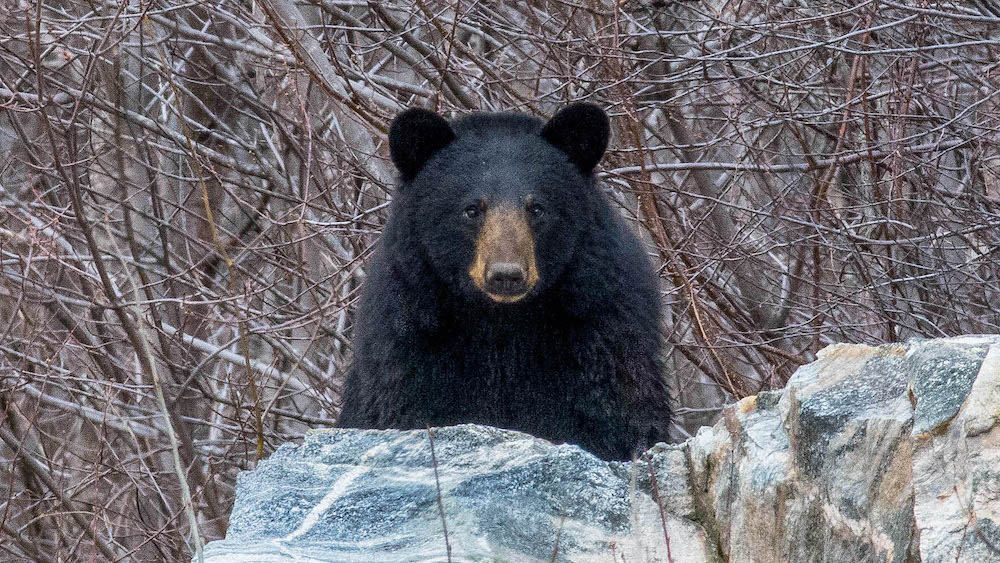
Bears
While there are no grizzly bears in Ontario, there are polar bears (Ursus maritimus) on the James Bay coasts. In fact, these polar bears are the southernmost population in the wild. For polar bears that are easier to see, the Polar Bear Habitat research facility offers glimpses of bears on a landscape similar to these James Bay bears.
Black bears (Ursus americanus) are widespread throughout the province. Bears probably cross the mind of every camper at least once. Black bears are large forest-dwelling omnivores that are found across Ontario and are an essential part of a healthy ecosystem. They are usually black in colour, but some regional variations can give them a reddish-brown “cinnamon” appearance. Males are much larger and can weigh up to 400 kg, while females only weigh up to 230 kg.
Black bears will eat anything and everything. Depending on the time of the year, they can be found snacking away in a blueberry patch or on flower buds, leaves or roots. They will also eat small mammals, insects, fish, or if there’s an opportunity, a deer fawn. They are also not opposed to eating dead animals or your camp food or garbage if it’s available.
The best time of the year to see a black bear is outside the winter months as they will crawl into their dens to snooze from late autumn to spring. Bears need about 20,000 calories a day to prepare for these winter months, so your chances of seeing black bears in Ontario are typically food related, often in a berry patch or along the side of a road. The highest black bear concentrations are in the northwestern part of the province, in the Sioux Lookout district.
Generally, wild bears turn and run if they cross a human. The exception comes when food is involved. If a bear is used to being fed by humans or is desperate to load up after a long winter, it may act a bit more erratically.
Usually, if you stumble across a bear in this manner, they will just flee. Sometimes they can become defensive, especially a mama bear with her cubs. If this is the case, stay calm, yell loudly and slowly back away. Throw objects and wave your arms if the bear does not go away. If you have it on you, use bear spray if the bear approaches or shows signs of aggression.
Check out more safety tips and black bear behaviour guidelines on the Ontario Bear Wise page.
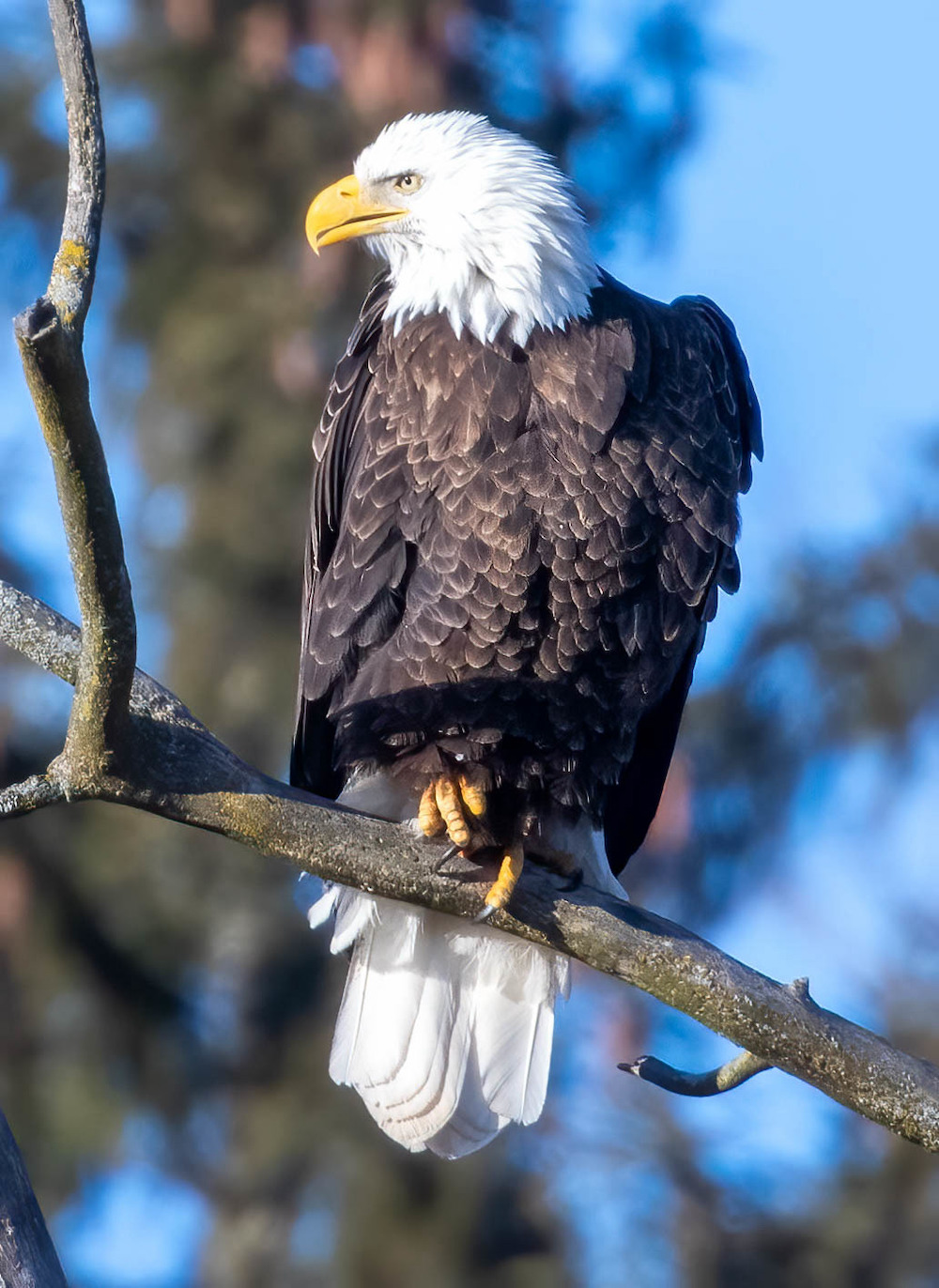
Bald Eagles
The bald eagle (Haliaeetus leucocephalus) is well known as a symbol of conservation after making a major comeback in population numbers after the pesticide DDT was banned. Once scarce, there’s a good chance to see bald eagles in Ontario, especially as you travel farther north—especially in the waterfront areas of cities like Sault Ste. Marie.
You will usually see bald eagles soaring above or near water, looking for their next meal. As they like to hang out near water, it makes sense that their preferred food is fish. But they’ll also take what they can get. Bald eagles are opportunistic eaters, eating anything from fish, small mammals, carrion and even pirating food away from other raptor species, such as osprey. Even though they weigh up to 6.4 kg (14 lb)—quite heavy for a bird!—they can carry over four times their weight while flying.
These large raptors are instantly recognizable, with adults’ white head and tail feathers, dark body, yellow talons and hooked beaks. Juvenile bald eagles are mottled brown with patches of white poking through. They are easy to spot in a blue sky or perched in the boreal tree line.
Bald eagles can be seen year-round, and they nest throughout Northern Ontario. Salmon and fall-spawning trout create a high-quality food source for eagles, and they often congregate along the rivers in late summer-early fall. Canoeing down a river like the Michipicoten River near Wawa gives a great opportunity to see them. In the winter, eagles will stick around open water patches or gather near municipal dumps, eating humans’ food scraps.
If you want to see bald eagles in Northern Ontario, head to any river or lake and keep an eye out. You can even try your luck near municipality dumps or take a road trip to Lake of the Woods. They have the highest density in Northwestern Ontario, as the effects of DDT did not impact this area.
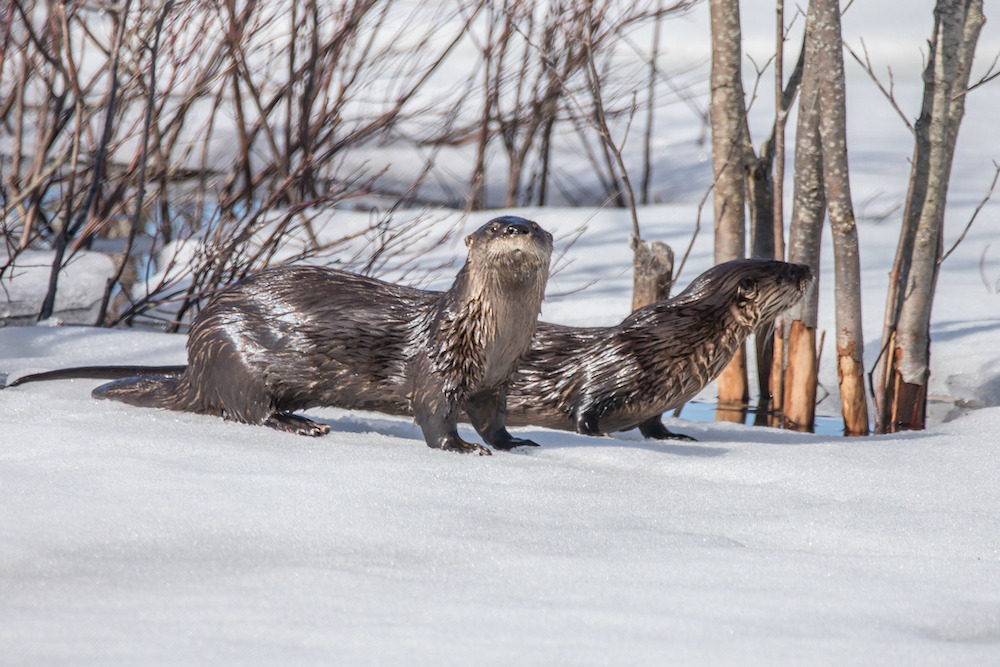
Otters
The northern river otter (Lontra Canadensis) is the only otter in Ontario. They have brown, water-repellent fur that keeps them warm in cold waters and can measure up to 1.4 m in length and weigh up to 14 kg (30 lb)! Their streamlined bodies with a long tapered tail make them excellent swimmers. Otters use their long whiskers (called vibrissae) to help them find their aquatic prey items such as fish, crabs, turtles, clams and insects. And after every meal, river otters wash themselves to maintain their beautiful fur.
Although their range takes them all across North America, your best bet at catching these playful creatures is—you guessed it!—by a river. They eat fish and invertebrates, so it has to be a big enough river to feed them. This semiaquatic mammal is a part of the mustelid family (weasels, minks, marten, fishers, skunks, badgers and wolverines), but they have a reputation for their sense of play. You can see them wrestling, chasing one another and playing games. Look for their belly marks in winter as they slide across the ice or down river banks.
River otters are most active at dusk and dawn. Early spring is your best chance to see them playing around or chowing down on a fish; their dark-brown coat will stand out on the ice or snowbanks. That is not to say they are impossible to see in the summer, but they blend in against the water in the warmer months. If you see one dive, be patient: they can hold their breath for up to eight minutes!
Flying squirrels
Birds aren’t the only things flying in our forests. As night comes, red squirrels sleep, and their flying cousins take over. There are two types of flying squirrels in Ontario: the northern (Glaucomys sabrinus) and the southern (Glaucomys volans). The species have some range overlap in Southern Ontario, but the northern flying squirrel is much more widespread. Because they are nocturnal, flying squirrels are seldom seen, even though they are pretty common.
You might know this, but flying squirrels don’t fly as much as they glide, jumping from high up and coasting to their destination with the aid of skin folds running between their arms and legs. Picture the high-adrenaline Red Bull wingsuit flyers but as a squirrel. They live in hollow trees, using abandoned woodpecker nests. Flying squirrels don’t hibernate and stay active year-round. To keep warm through the depths of winter, they team up and form “cuddle puddles” to conserve body heat by snuggling up with up to nine other flying squirrels. Another curiosity of these obscure animals is that they glow pink under UV light. No one is really sure why, although there are theories that it makes them more attractive to potential mates.
Finding flying squirrels is easiest in the fall or winter when leaves drop from trees. They often raid bird feeders after dark, so keep an eye on them late at night. They prefer forests with large trees for roomy nest hollows. Old growth forests with many large trees tend to have higher flying squirrel populations.
Moose
A moose (Alces alces) encounter can make even the most seasoned outdoor enthusiast stop and stare. It’s a marvel of nature that an animal this large can live in forests with such tight trees and rugged landscapes, even making life more difficult by growing a massive set of antlers on its head. The antlers you see on a bull moose’s head regrow yearly, which is impressive considering they are as heavy as 13 kg. The incredible size of a moose is thanks to its plant-based diet. Moose spend most of their time foraging, eating the shoots and leaves of various plants. In the summer, moose particularly prefer aquatic plants. They can dive 6 m down to chomp on the most nutritious parts of plants.
While you can find moose in many habitats, near water is the best place. In summer, they feed on aquatic plants and sit as low in the water as possible to beat the heat and escape the torrent of bugs. Biting insects are the same reason they are also seen frequently on roadsides, catching any breeze they can for temporary relief.
They become especially active during late summer when their mating season begins, known as “the rut.” During this time, male moose stop eating and focus all their energy toward attracting a mate. In the moose-world, it’s all about who has the biggest antlers and who is the strongest. The winner of fights has the rights to breed with cow moose in the area. During the rut, moose often congregate around clearings where this fighting can happen. Younger bull moose practice sparring with each other; it’s not uncommon to find two younger ones spending time together, frequently testing their strength and technique. Maybe next year they will be strong enough to compete in the proper fights for the cows.
This time of the year moose can be dangerous to be around. Hormone levels are high, and bulls can be aggressive. Moose-human encounters are rare but in some instances people have been charged by them. A more common danger with moose is collisions on the road. Drive with caution, especially at night in moose country.
In Ontario, moose populations are especially concentrated in boreal forests, or areas which have been logged previously; besides aquatic plants, moose love to eat the regrowth in clearcuts. Take a trip to the Chapleau Crown Game Preserve and explore the waterways there for a great shot at seeing moose in the wild. Also in the northeast, Ivanhoe Lake Provincial Park is famous for its curiously high population of albino “spirit” moose. In addition to seeing them on a summer canoe trip, you may also find moose during the fall rut. This is also hunting season, and it’s wise for anyone who is heading into the forest to wear hunter’s orange.

Lynx
Canada lynx (Lynx canadensis) are widespread across the north woods, but seeing them is another story.
These big cats are masters of stealth, moving silently as they hunt. With their superior hearing, they tend to slip into the thickets well before humans spot them. Lynx are the second-largest cats in North America after the cougar. They live across the boreal forest, occurring sparsely throughout the province, generally north of Algonquin Provincial Park.
Lynx hunt by stalking their prey. Their wide feet allow them to float over the snow, and their thick fur muffles any sounds they make. Populations are linked to their food availability. If snowshoe hare numbers rise, then there’s more food available, and more lynx will successfully raise young. This trend continues until too many lynx are suddenly competing for too few hares, and both populations drop off.
Like many of these animals, seeing lynx in Ontario is much easier in winter, when fewer leaves block views. They also make distinguishable tracks in the snow. Look for round tracks without claw prints (cats can retract theirs). You’ll see four toe pads and a “palm” in a fresh print. There may be a lynx nearby anytime you’re walking in the woods. If you happen to stumble upon one, sometimes they just sit perfectly still. It’s incredible how well their patterned fur camouflages them.
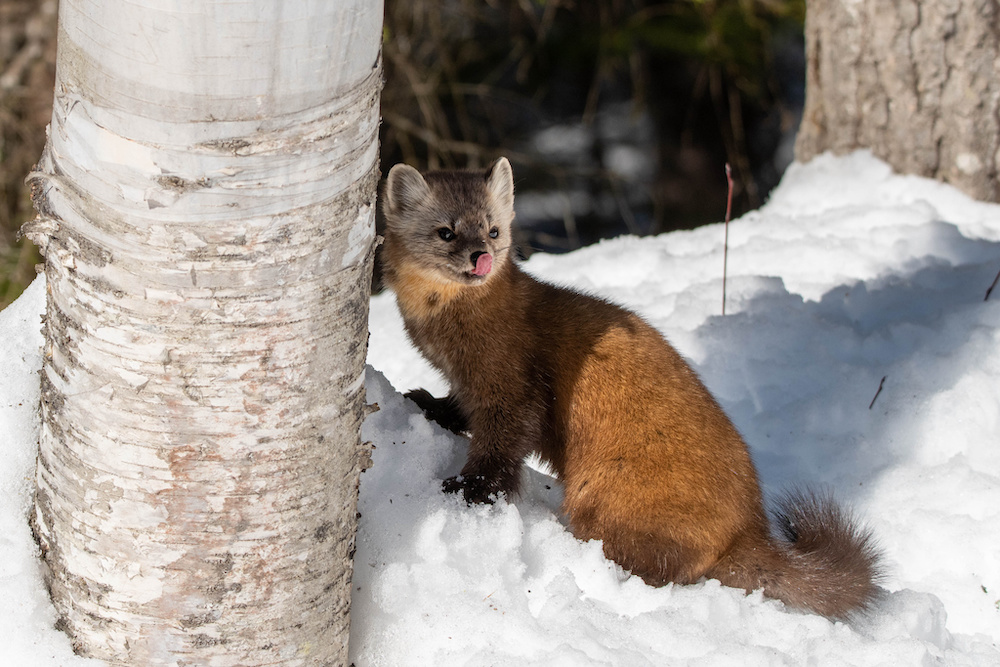
American marten
The American marten (Martes americana) is an adorable (yet feisty) member of the weasel family. They are the North American counterpart to the Eurasian pine marten, although they are informally called pine martens in Ontario.
A bit smaller than river otters, the biggest males are about 65 cm long (including their bushy tails). Although they are widespread across northern forests, they aren’t often seen. When humans are around, they’ll scurry up a tree with their semi-retractable claws. They are carnivores, primarily eating small mammals like rodents but will also scavenge if the opportunity presents itself.
Unfortunately, due to their tendencies to scavenge, aspiring “nature photographers” have been recorded using bait in attempts to attract marten for better shots. This puts the animal at risk, reducing their fear of humans which can expose them to risks of attacks by pets, harassment, or getting hit by vehicles. Like any animal, seeing them is a privilege and not something to be expected. The wildness is what makes the encounter special.
Martens are year-round residents but are easiest to spot in the winter when their dark-brown fur stands out against the snow. They prefer large tracts of unbroken forest away from development, so provincial parks are a good bet to find them. Algonquin Provincial Park has a high concentration of martens, which return to the same areas fairly regularly. Stay at one of Mew Lake’s roofed winter accommodations and you may catch a glimpse at a marten in the woodlands.
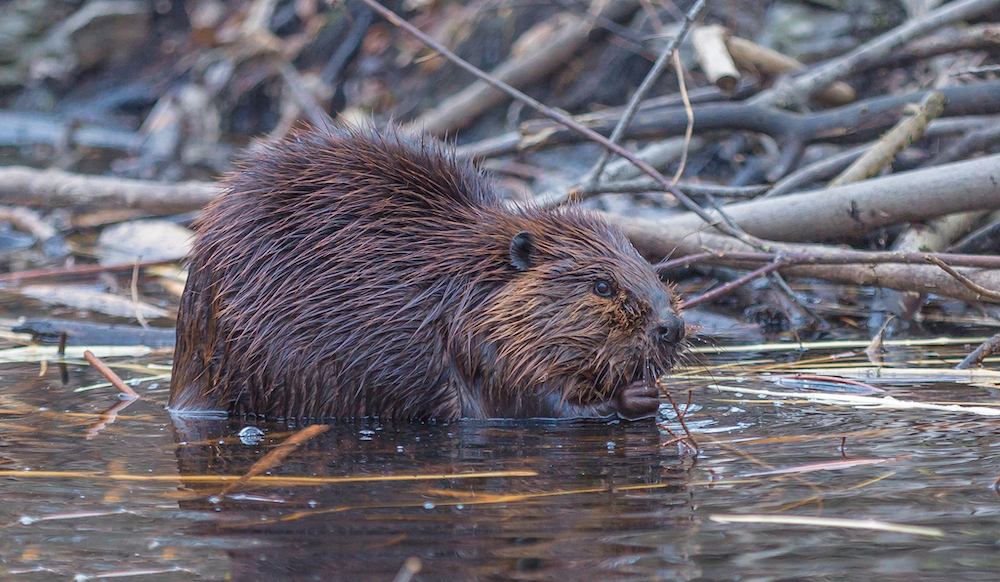
Beavers
Few animals shape our landscape as much as the iconic, plucky beaver (Castor canadensis). These “ecosystem engineers” are Canada’s largest member of the rodent family, weighing as much as 32 kg. Beavers can drastically alter the landscape (usually for the better) by damming rivers and creating wetlands. With their strong teeth beavers chew down trees, eating the tender inner bark and dragging the trunks across creeks. This slows the flow, creating a pond the beaver will call home. The world’s biggest beaver dam is almost 800 m long in Wood Buffalo National Park.
Beyond dams, beavers build their homes, called “lodges,” on the water. Covered with chewed sticks on the outside, the beaver digs a tunnel for underwater access. This affords protection from wolves, their main predator. In addition to their oversized teeth, beavers’ flat tail is another unusual feature. It aids in swimming, and when they sense danger, they slap it on the water to let other beavers around know. The sound resonates across the entire lake or pond the beaver is on. They are social animals, with a pair working together to build the dam, maintain the lodge and raise their kits.
Beavers are widely distributed across the province, with an estimated population of over 5 million. Look for the tell-tale signs of beaver activity: a dam, lodge or chewed tree stumps. Beavers are most often seen in the morning or evening when they swim across the pond from their lodge to wherever the “job site” is for the day. Your best chance to see beavers is in any provincial park or parcel of Crown land. They prefer hardwood trees, especially aspen, birch and willow.
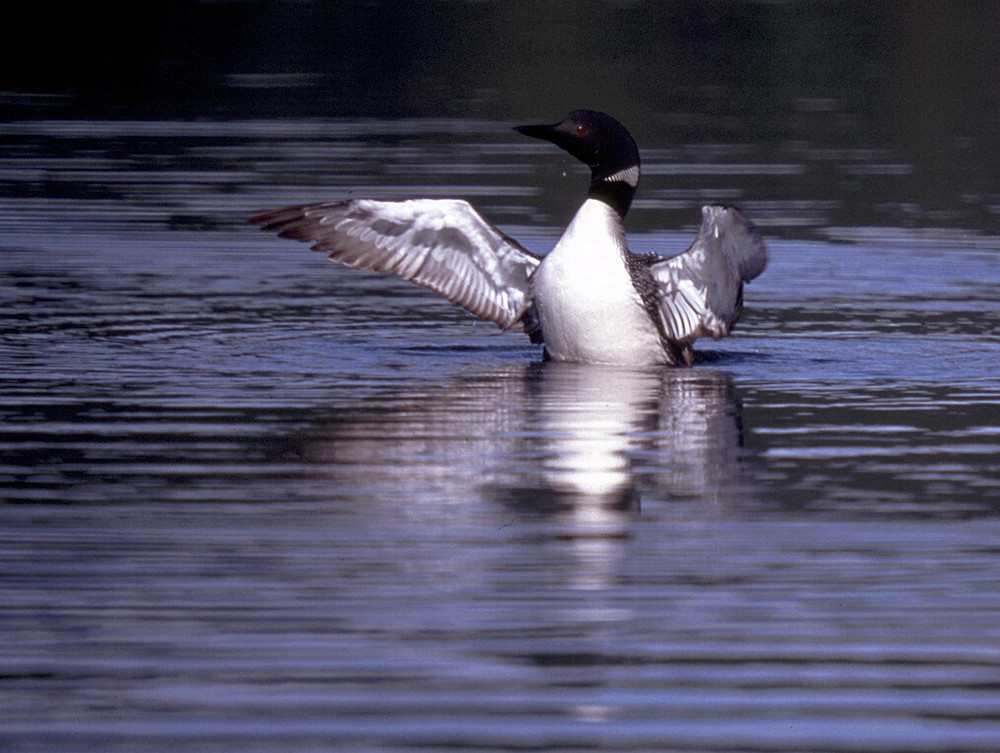
Loons
The common loon (Gammia immer) was selected as Ontario’s official bird. It’s on our one-dollar coin and synonymous with lakes, camps and summer. The haunting call lingers in memories, as does their dark silhouette on a still lake at dusk. These waterbirds are incredibly efficient divers, eating almost exclusively fish. They are so adapted to swimming that they are rather awkward fliers. Loons need a long stretch of open water to use as a “runway” for taking off.
They are also indicators of a clean, healthy lake. Seeing a pair of loons with chicks on a lake means the lake has enough food to support them, and the water is clear enough for them to dive and catch the fish. Seeing the chicks when they’re young is extra adorable: the parents swim around with them on their backs!
The best time to see and hear loons is during summer, especially during the breeding season June and July. In Ontario, loons are on lakes full of fish and have tall vegetation for them to put their nests in. Listen for them calling, especially around dawn and dusk. In spring and fall migration, they are commonly found on bigger water as they make their way to their wintering areas on the east coast. Look out from the shorelines of the Great Lakes and Georgian Bay to see them bobbing around. The common loon’s cousin, the beautiful red-throated loon (Gavia stellata) makes rare appearances during migration, often where common loons are found.
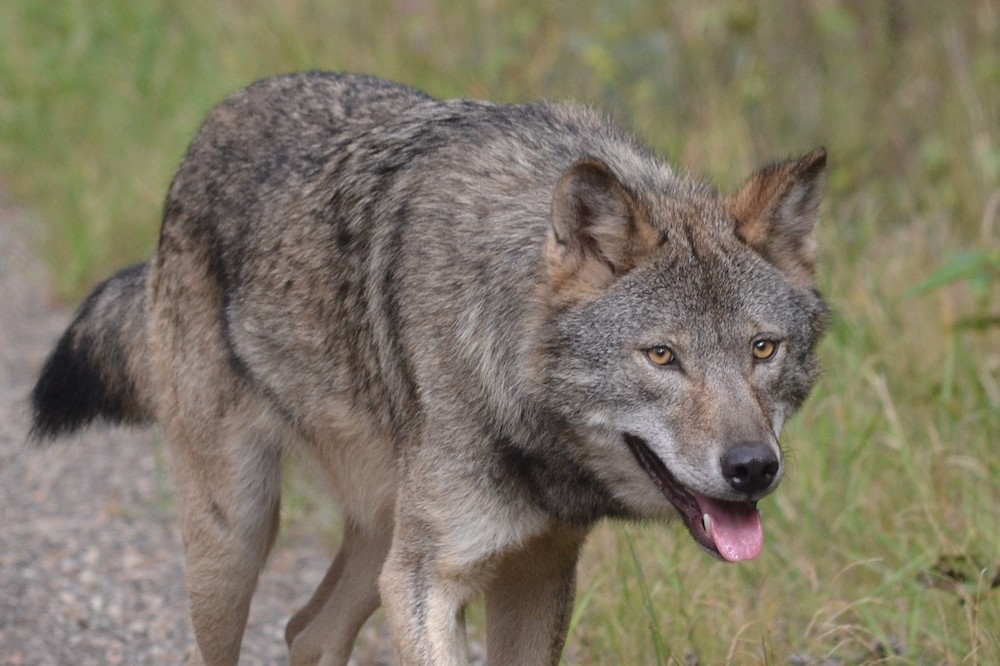
Wolves
The wolf is another icon of the wild. As top predators they serve an essential role in keeping the ecosystem in check. They primarily prey on beaver, moose, deer or caribou, depending on where they are and what’s available.
Ontario’s wolves range from Algonquin Provincial Park and throughout the north, but they are not all alike. The boreal forest is grey wolf country. These are North America’s most widespread wolves, occupying much of Northern Canada and the upper United States. Grey wolves are highly social animals who hunt in packs, but recent work with GPS collars has found some solitary wolves to wander incredible distances. One collared wolf from Michigan was recorded making a meandering 6,700-km journey from the Upper Peninsula all the way to the Ontario/Manitoba border! Grey wolves are some of the biggest wolves, weighing up to 65 kg (145 lb). They’re somewhat reminiscent of a German shepherd with their long, muscular bodies and shaggy fur, and are seen in a range of colours, including blond, brown and jet black.
The so-called “eastern wolf” (Canis lycaon) is more cryptic. This exceedingly rare resident of Southern and Central Ontario has been subject to genetic mixing with coyotes and grey wolves. The Ontario Committee on Status of Species at Risk in Ontario (COSSARO) has argued to rename the remaining “pure” strain of the population as the “Algonquin wolf,” because its range is largely limited to Algonquin Provincial Park. This conclusion is a hot debate in scientific circles, with some wildlife biologists making the case that the eastern wolf is actually a subspecies of the grey wolf carrying the latin name Canis lupus lycaon. No one has asked the wolves for their opinions in this discussion.
What you need to know is that eastern or Algonquin wolves are a hybrid between the three other species, sharing characteristics of all. They are smaller than a grey wolf, but bigger than a coyote. They hunt in packs like wolves, but can also scavenge and live on their own if needed.
Being fortunate enough to see a wolf in the wild is largely a game of chance, but you’ve got a good shot at hearing them. Stay up late and you may hear their iconic howls. Wolves howl all year long, but in the winter sound travels farther, and their howls pierce the silence. Not to say you can’t hear them in the summer either. Generally, wolves thrive where humans aren’t. Travelling deep into the backcountry will drastically increase your odds. If you’re set on seeing wolves, Muskoka’s Wolf Centre provides an opportunity to see these canines (Algonquin wolves) up close through one-way mirrors.
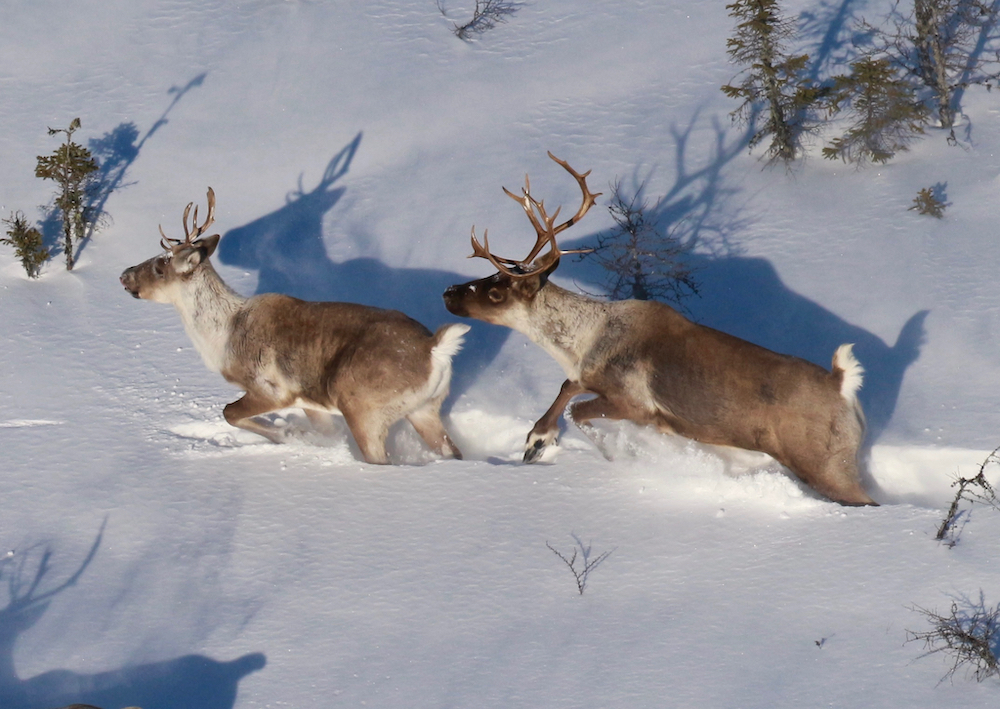
Caribou
Woodland caribou (Rangifer tarandus) are emblematic of the boreal forest and wilderness. These forest-dwelling ungulates (hoofed-toed mammals) once lived as far south as North Bay. They are related to moose and white-tailed deer, but unlike them, both sexes of caribou grow antlers. Males have massive ones, which are used for attracting mates during their breeding season. They drop these shortly after. Female caribou grow smaller antlers, which stay on throughout their pregnancy, an adaptation that is thought to give them protection against predators.
While they are the same species that have herds in the tens of thousands in Alaska and the Yukon, caribou in Ontario number about 5,000 total, according to the best estimates. The population has suffered as industry marches north, building roads and clearcutting forests, and in the process taking up caribou habitat and inviting higher numbers of predators like wolves along.
The only way to see a caribou in Ontario is to go where the roads aren’t, and even then it is purely chance. They prefer to stay away from humans, but you might catch a glimpse of one swimming across a remote lake in Wabakimi Provincial Park or the aptly named Woodland Caribou Provincial Park. For some time, there was a holdout population on Lake Superior’s Slate Islands near Terrace Bay, but wolves walked across on ice from the mainland one year and the population crashed. Caribou are one species that many of us will never see, but just knowing healthy wild populations exist is a reassuring feeling.
Massasauga rattlesnake
The Massasauga rattlesnake (Sistrurus catenatus) is a stout-bodied snake that grows up to 60 to 75 cm long. It has a grey to dark brown body with “butterfly” or “saddle-shaped” markings down the back, alternating markings along the sides and a black belly.
Their distinguishing feature from other similar looking snakes is their rattle; these are the only rattlesnakes left in Ontario. Their rattle grows in interlocking segments as they shed their skin. The Massasauga snake’s rattle differentiates it from eastern foxsnakes and eastern milksnakes, which vibrate their tails when threatened.
Massasaugas live in various habitats throughout Ontario, such as tall grass prairies, bogs, marshes, shorelines, forests and alvars. As “cold-blooded” species they require open areas to warm themselves in the sun. They hibernate underground in openings in bedrock, sphagnum swamps, tree cavities, or making use of deserted animal burrows.
The Great Lakes and St. Lawrence population found along Georgian Bay is listed as Threatened. In the southwestern part of the province, near Windsor, the Carolinian population is Endangered, with less than 100 left.
Your best chance to see this snake is in the Georgian Bay Biosphere or along the Bruce Peninsula. Although previously widespread along the Great Lakes, persecution by humans, mortality on roads and loss of habitat have led to the disappearance of their historic range and population decrease. Massasauga rattlesnakes get a bad reputation and spark a lot of fear. In reality, only two deaths in Ontario have ever been attributed to these snakes. Their first reaction to a potential threat (like a human) is to remain completely still, letting their exceptional camouflage conceal them.
If you come across a Massassuaga rattlesnake make sure to report the sighting to the Natural Heritage Information Centre, or on iNaturalist with photographs and coordinates.
Five-lined skink
The five-lined skink (Plestiodon fasciatus) is Ontario’s only native lizard species. This small lizard is less than 10 cm and rather tricky to spot. It is black or grey coloured with five cream-coloured stripes along its back (hence the name).
Skinks change colours through their lives. Juveniles can have a blue tail but will fade with age; during breeding season, the males get an orange colouration around the jaws and chin. With their keen sense of smell by flicking their tongue in and out of their mouth to pick up any chemical signals, these tiny lizards hunt a variety of insects, spiders and worms and other invertebrates.
What else makes these creatures stand out is their defense mechanism—the ability to detach a part of their own tail and regrow it. The detached tail will squirm and wiggle for just long enough to distract the skink’s predator just long enough for them to get away. A new tail will eventually grow back, but only shorter and less colourful.
Like the Massasauga rattlesnake, this species is found exclusively in Southern Ontario with two distinct populations. A very limited Carolinian population lives along the shoreline of Lake Erie and a Great Lakes-St. Lawrence population is found from the Georgian Bay coast to Eastern Ontario. If you’re in that area on a warm summer day, you might catch a glimpse of these lizards basking on sunny rocks and logs so that they can maintain their preferred body temperature of 28 to 36 degrees Celsius. If it’s not so warm and sunny, they will be underneath logs or rocks on open bedrock in forests. Access to woody debris like fallen, rotting trees is vital for maintaining their body temperature.
Like most other reptiles and amphibians, they are cold-blooded, and during the winter months, they hibernate buried in the soil or deep within rock crevices. They emerge from hibernation in early May and are active until late September to October.
Five-lined skinks are listed as Endangered in the Carolinian population and Special Concern in the Great Lakes-St. Lawrence population under the Species at Risk Act in Ontario. There are many threats to these lizards, such as habitat loss from urban development and agriculture, illegal collection for the pet trade, ATV and road mortality, and removal of woody debris and overturning of rocks by humans and black bears. If you find yourself in skink country in the summer, respect their habitat by not overturning rocks and woody debris to look for them, stay alert and reduce your speed while driving or biking, and help by reporting any sightings to Ontario Nature, NHIC, or on iNaturalist.
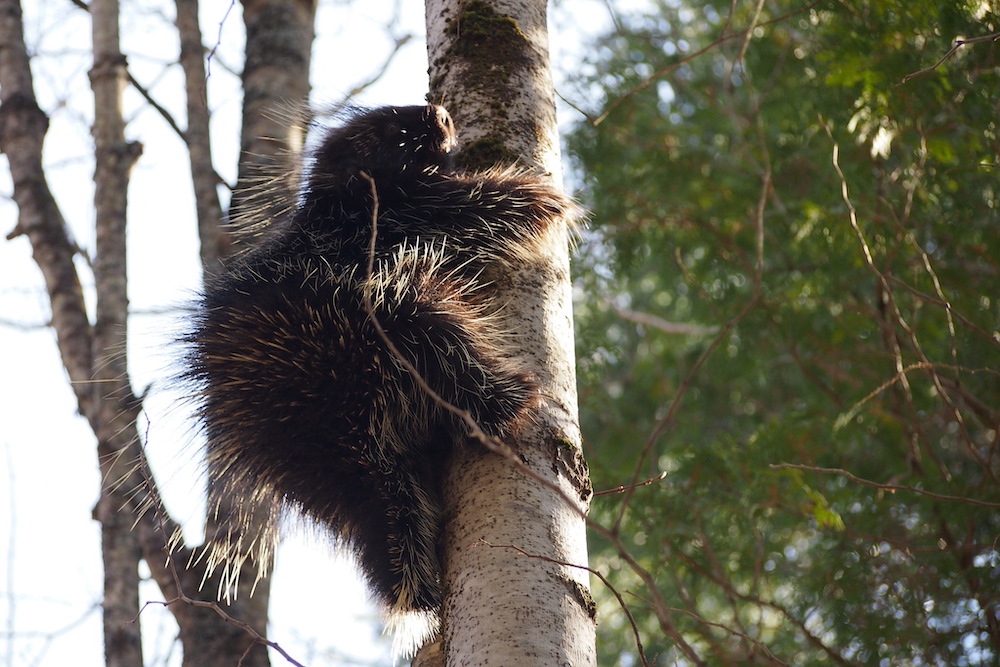
Porcupines
Porcupines (Erethizon dorsatum) are the second-largest rodent in North America, after the beaver, and can weigh up to 13 kg (30 lb), but most are closer to half of that. They have a stout body, covered with a spiny coat. These spines are called quills and extend from their head to tail. Each animal has approximately 30,000 of them, and they are covered in barbs which cause the quills to work their way deeper if they aren’t removed. These quills are enough of a deterrent that most predators steer clear. In addition to protection from predators, porcupines will actually stab trees as they climb, helping them maintain their balance.
They are known for chewing almost anything. So, if you are leaving things outside, be wary that it is fair game to porcupines. Their diet is mainly woody materials, including twigs, buds, shoots, leaves and needles.
North American porcupines range from the Arctic Ocean down to Northern Mexico. They are especially abundant in the northern part of the Great Lakes region, but they also live in open tundra, southern forests and can adapt to cities.
Porcupines are mostly nocturnal, and the best time to see them moving about is around sunrise and sunset. In the winter, they are more active around daylight. You can see them feeding in trees or on the ground, eating leaves of shrubs and herbs or alongside roads. A look for trees that have been chewed or “girdled,” stripped of their bark all the way around.
A common misconception is that porcupines can shoot their quills. They are mostly peaceful and would prefer to be left alone. However, if you do find one and get too close, they will raise their quills and lash its tail to warn you off. You do not want to be picking those quills out!
Keep your eyes peeled
There’s a lifetime of opportunity in observing Ontario wildlife. The key to a good experience is to bring your sense of wonder; you never know what you may encounter in the natural world. Most importantly, be respectful of wildlife and give animals the space they need to thrive.
Recommended Articles
Girls’ Getaways

Explore and Relax: Ontario Spas for Outdoor Lovers
Can't-Miss Skating Trails & Outdoor Rinks

Happy Tails
Summer Fun Ideas
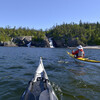
Paddling the Pukaskwa National Park Coast

Want to go snowshoeing?

Adventure Films

Want a magical day?
Take a ruff ride

A Journey He Will Never Forget
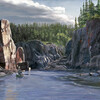
How wilderness art can enrich your life
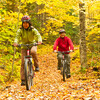
THANKSGIVING WEEKEND

Top 10 parks Canada Adventures

Heart, spirit and passion

get on board

Looking for a rush?

Want to get high?

want a Challenge?

